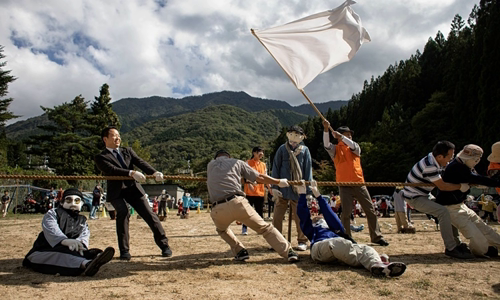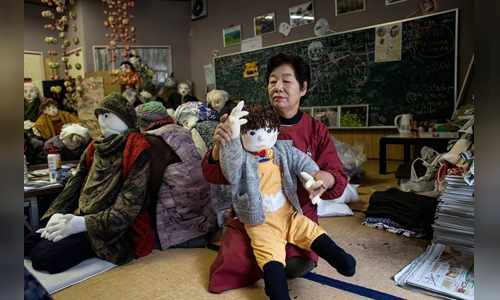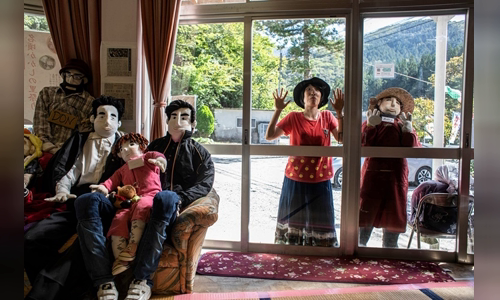One beautiful autumn day, Tsukimi Ayano brought 40 large dolls to a school in Nagoro village on Shikoku island of Japan.
With the help of several villagers, Ayano, 70, arranged the dolls to join the tug of war between the abandoned school campus. She recreated all the typical activities at the school on a typical sporting event. For the past 7 years, she has held a doll-like festival every year.

Nagoro villagers playing tug of war next to the dolls at the school sports festival were recreated Photo: NYTimes
"We no longer see children here," said Ayano, who was born in Nagoro. "I wish there were more children because it would be more fun. So I made the kids myself."
The last child to be born in Nagoro village 18 years ago, this small village on the banks of the river on Shikoku Island now has just over 20 adults living on it. The primary school has been closed since 2012, not long after the last two students completed grade 6.
Japan's population is aging and declining. Rural areas are most likely to feel this, where birth rates are low and people are even more reluctant to have children because of limited job opportunities and uncomfortable living conditions.
"There is no chance for young people here," Ayano said. "They can't make a living here." In the past, Nagoro village had a clinic, a restaurant and even a pachinko card shop. But now, the village doesn't have a store.
About 350 dolls made by Ayano and her friends outnumber the village residents by 10 times. She placed dolls everywhere to remind her of the bustling period, simulating an old lady tending to a roadside tomb, while another person was sitting in a wheelchair.
The doll was also arranged by her as a construction worker group to smoke at recess, while some concentrated on waiting for the bus. A father pulled a wagon full of children. A naughty person shaking chestnuts from a tree.
Inside the elementary school, the doll is placed on the stairs or in front of the teacher to learn eternal lessons. Ayano is a witty person who gives her dolls a lot of special expressions and shapes. Therefore, the village of Nagoro does not bring the feeling of horror as many people think.
"I don't think it's scary," Fanny Raynaud, 38, said. Raynaud is a nurse from France who is traveling around Japan with her husband, Chris Monnon, 55 years old. They stopped in Nagoro after reading an article about the village online. "I think this is a great way to bring the village back to life," she said.
Nagoro Village located in the Iya valley has never been crowded. Even when Ayano was young, the village population was only about 300 people. Shikoku is the smallest and most sparsely populated island of Japan's four main islands.
In the 1950s and 1960s, the area became crowded with road construction, deforestation to build hydroelectric plants. When the dam was built, a lot of people left. Those who stay behind use pumps to pump water to grow vegetables.

Ayano is beside the dolls made by her own hands Photo: NYTimes
To reach the nearest supermarket and hospital, Nagoro residents have to drive an hour and a half through narrow, winding roads.
"You must absolutely love mountain life to live here," said Tatsuya Matsuura, 38, the youngest resident of Nagoro. "I think a lot of people will have problems."
Matsuura once ran a guesthouse left by his father as a base for climbers of Tsurugi, about 10 km from Nagoro. Three years ago, the business was not going well, the Matsuura family had to close a general store and boarding house in Nagoro.
"If we continue to follow the path that has been going for the past 10 or 20 years, the rural areas will be shrinking and people will continue to concentrate in big cities," said Hiroya Masuda University of Tokyo professor, commented. "Many communities will eventually disappear".
Nagoro is one of the small villages that are gathered together into a residential area where more than 40% of people are over 65 years old. Even with childcare subsidies, medical discount policies or housing assistance, local governments are still unable to attract newcomers or returnees.
The government has merged many schools and spent more than $ 8 million to build a spacious new school but currently has only 38 students.
Most students move to larger cities to study and work.
"We want them to choose the life they want," said Hiromi Mukai, principal of Higashi-Iya Elementary and High School. "That is inevitable".
Ayano left Nagoro village when he was 12 years old. At that time, her father took a job at a food company in Osaka. She met and married her husband, giving birth to two children.
After retirement, her father returned to Nagoro to help take care of ailing father-in-law and a wife with kidney failure. 16 years ago, Ayano returned to the village to take care of his father. He is now 90 years old, the oldest resident of Nagoro.

A tourist mimics the expression of a doll in Nagoro village Photo: NYTimes
In the field in front of their house, she sowed turnips and beans. The birds dug up them so she made a scarecrow imitating her father's dressing style.
"It looks like a real person, not an ordinary scarecrow," Ayano said. "That's why it gets the job done".
After that, she continued to add 3 to 4 female-shaped dolls that were weeding in the field and others standing by the road. When several travelers passed by to see and ask for directions on the dolls, Ayano was so excited that she decided to devote herself to making dolls.
Ayano now occasionally teaches doll making classes in the nearby town or guides visitors to her workshop, built from an old kindergarten. Sometimes, she receives special orders from around the country. A doctor whose wife had recently died of cancer had asked her to make two mannequins for his wife, one for him in the living room, and the other for him in the bedroom.
Ayano left a doll imitating her grandmother in the backseat of her car to "never feel lonely".
The day before the re-enactment of the sports festival at the old school in the village, Ayano created quite a lot of different scenes with the help of his sister, brother-in-law from Kyushu Island, southern Japan, a love group. College volunteers and some villagers.
When the festival started, people started opening stalls selling soba noodles, chips and octopus.
Osamu Tsuzuki, 73, leader of a local construction company, gave a welcome speech. "On behalf of the staff, the villagers and over 300 dolls, we welcome all of you," he declared.
According to Kayoko Motokawa, 67, Nagoro village is now more famous for dolls than for humans. "If it were real people, this place would really be a happy village," she said.



 EclipseOyaVault
EclipseOyaVault







